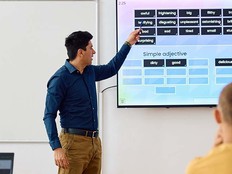Acquaint Youngsters With Technology and Produce Independent, Critical Thinkers
At any school or district, the IT department's most important customers are the teachers, administrators and students who depend on technology to enhance the learning experience.
Many teachers rely on technology in their classrooms to bring lessons to life through the use of mobile devices, interactive whiteboards and document cameras, to name a few. Meanwhile, students' classroom needs continue to evolve, and the competitive advantage created by the use of technology is increasingly important.
In a recent survey by Project RED (Revolutionizing Education), the preliminary results of the academic impact at schools using technology show a 62 percent increase in high-stakes test scores, a 48 percent decline in disciplinary action and a 39 percent increase in college enrollment among students at the schools surveyed.
To attain those results, school administrators are recognizing the importance of introducing technology to students at early ages to maximize impact. At East Kingston Elementary School in New Hampshire, kindergarten teachers have begun to acquaint their students with the computer keyboard and mouse. Such familiarity helps set the stage for learning going forward, says Principal Jim Eaves.
Twitter: To keep updated on the latest education technology trends, best practices, case studies and product reviews, follow @EdTech_K12 on Twitter.
Technology also helps prepare students in a more fundamental way: as critical thinkers who are capable of learning on their own. That's a lesson that can't begin too early, says Heather Reed, tech coordinator at East Kingston.
Because students now arrive at school, even as kindergartners, with some awareness of technology, introducing it to them early makes sense. Technology is already part of how they interact in the world, says Stein Brunvand, a University of Michigan-Dearborn assistant professor of educational technology.
IT Training for the Teaching Staff
According to a study by the National Center for Educational Statistics, school districts are offering teachers professional development in topics such as integrating technology into instruction (95%), using Internet resources and communication tools for instruction (91%) and Internet safety (89%). In fact, most districts (55%) require that teachers take online safety training.
“Teaching technology is not the goal; it's teaching with technology,” says Brunvand, who teaches a course on incorporating technology in elementary classrooms.
Teachers need to engage students in as many ways as possible and also prepare them for the real world. Technology is ideal for achieving both of those objectives, says East Kingston's Eaves.
Students aren't the only beneficiaries: Teachers find that classroom technology allows them to skip steps in creating, re-creating and reusing lessons. They also can use the tools to attain instant feedback about how well students grasp a concept, letting them pace lessons appropriately.
Because the materials are in an electronic format, reuse of curriculum content can take place with a minimum of prep time, says East Kingston Elementary first-grade teacher Marne Dohrmann. “If I need to revisit the lesson again tomorrow because they didn't quite get it, I don't have to create it again on paper because it's saved.”
For more information about how schools and districts are adopting classroom technology for their youngest students, read “From the Get-Go.”
Seeing Green: Interactive Whiteboards
Walk into most elementary schools and you will find charts of poems, songs and other teaching materials hanging from modified coat hangers, says Jim Eaves, principal at East Kingston (N.H.) Elementary School. With interactive whiteboards, teachers can now put all that material on their computers.
Although the school hasn't measured return on investment, the boards definitely save time and money and reduce paper consumption, Eaves says. “You just have to create something once, call it up on your server year after year, and modify it to your current group of kids.”
For whiteboard best practices, click here.

Ryan Petersen
EDITOR IN CHIEF







